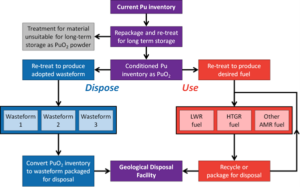The UK is currently storing around 140 tonnes of plutonium, mostly arising from its civil nuclear programme over the past 60 years. What should we, as a nation, do with it? Should we use it as fuel for future reactors, or dispose of it as waste? The latest position paper from the Dalton Nuclear Institute addresses this question, and makes key recommendations to government and industry. In this article, Will Bodel from the Institute discuss the available options.
- Plutonium, used as nuclear fuel, is incredibly “energy dense” and the stockpile could be a vital contribution to Britain’s Net Zero ambitions.
- However, burning the plutonium as fuel requires considerable planning and upfront investment to deliver the appropriate facilities, and ensure we have the right reactors to use of the fuel effectively.
- Given the UK already needs a geological disposal facility for its waste, regardless of what happens with our plutonium, would it be cheaper and easier overall to dispose of plutonium as waste?
Repackaging
The storage cans which currently contain the plutonium are deteriorating, which is why the Nuclear Decommissioning Authority (NDA) is repackaging it into more robust storage, suitable for the next 100 years. This is essential to minimise the hazards otherwise presented by the stockpile, and will take decades to complete. The government therefore has ample time to decide and implement a suitable plutonium strategy. However some relatively early decisions remain necessary – because while there are good options available now, even early steps along one pathway can close off other (potentially better) options. Therefore, the government must develop a full understanding of the whole plutonium lifecycle for each pathway before committing to irrevocable decisions.
Figure 1. Flowchart showing the Dispose versus Use paths.
Use?
Utilising the plutonium for nuclear fuel could have enormous benefits. Current UK reactors use uranium for fuel, but less than 1% of natural uranium can create energy in this way, so 99% of the material mined remains unused, needing to be stored or disposed of. Plutonium can be used alongside uranium (in so called “mixed oxide” or MOX fuel) in conventional reactors, or as fuel in its own right in advanced reactor designs.
Future fast reactors offer a way to utilise the vast amounts of otherwise unusable uranium by generating useable nuclear fuel from it. To do this, plutonium is needed to “kick-start” the reactor and begin the process. Using the UK’s plutonium this way would generate vastly more energy than we could get from simply using it as nuclear fuel in its own right in conventional reactors. Burning the plutonium in conventional reactors (if fully used up) would still produce a huge amount of energy – around 3,000 TWh in total (which is around twice the current total annual energy consumption of the UK). However, using the plutonium in conjunction with the UK’s stockpile of uranium could increase this to around 2,200,000 TWh – enough to supply the whole UK with low-carbon energy for many centuries.
…or dispose?
While this sounds a compelling argument for using the plutonium as fuel, successfully delivering on this potential would require a clear national strategy to do so, coupled with considerable planning, investment, and effort.
Planning to use the plutonium as fuel brings other challenges too. Plutonium is potentially very hazardous, so any facilities associated with its handling, processing or transportation need to incorporate multiple levels of shielding to ensure it cannot find its way into the environment. It can also be used in nuclear weapons, so robust and expensive security measures must surround every aspect of its storage, use or movement. A plutonium store is one of the most “security sensitive” facilities a nation can contemplate.
Even the word plutonium is so emotive (carrying significant connotations of danger and mystery) that the most minor incident involving its use is guaranteed to become a major news story, with reputational damage to the country involved and the global nuclear industry.
Combined with the uncertainty of the economics of using plutonium as fuel, along with the fact that the UK already needs a geological disposal facility for its waste, these factors all weigh heavily in support of the case for disposal as waste at the earliest possible opportunity.
Making the decision
Given the difficult choice between Use and Dispose, keeping all the options open indefinitely sounds appealing, but unfortunately is not a realistic option. One key consideration is the form the plutonium takes. The biggest risk to health from plutonium is its radiological hazard, particularly if it is somehow inhaled. Continued storage in a powdered state therefore perpetuates this risk. But converting the powder to a – much safer – solid form would effectively remove the option to use the plutonium to generate energy in the future. A decision must be made, and it must come from the government.
To complicate matters further, the choice is not as binary as has been presented thus far. If Disposal is the end-goal, several wasteforms and disposal methods are under consideration and need to be assessed. And Use in reactors requires different facilities depending on whether it will be used in conventional water-cooled reactors or next generation high temperature or fast reactors.
Making the best decision is therefore not easy and will require a comprehensive assessment of the costs and benefits of each option to determine which is best for the UK. Such an assessment will require an in-depth evaluation of the economics, safety, security, and available industrial capacity for each part of any potential plutonium lifecycle. Additionally, regardless of which strategy is eventually implemented, and as with most challenges facing the nuclear sector, a supply of suitably qualified and experienced staff for the duration of the process is essential.
This is alongside other key policy challenges for the UK Government to address;
- The government needs to develop a full understanding of the whole plutonium lifecycle for each pathway before committing to irrevocable decisions.
- Government should instigate an assessment of the options available for the plutonium stockpile and decide on its preferred end point.
- Government should ensure there is a sufficient supply of suitably qualified and experienced personnel to deliver the programme.
Whatever the decision of policymakers, it is clear that the preparation must start now, and must include a long-term vision for managing the UK’s plutonium stock.
To learn more about the conversation surrounding this issue, read the latest publication from Dalton, Managing the UK plutonium stockpile: no easy choices.
The image used for this article was kindly provided by the Nuclear Decommissioning Authority, and depicts the current plutonium storage facility at Sellafield.

